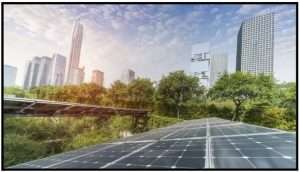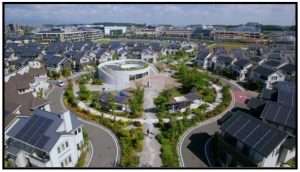Professor Dr. Riyadh Kadem Salman al-Jumaili
College of Education for Humanities / Department of Applied Geography

Introduction: Contemporary lifestyles have witnessed great development in all aspects of life thanks to the development of modern technology methods, including the city itself in which we live. What is essential in this is how the city was able to employ modern technology to its advantage until it produced a new urban model known as the (smart city), which is intended to be led through technological applications and reduce its urban character to a virtual character managed through computer screens and mobile phones. Moreover, the steps of urban planning for cities have become directed towards this direction, reaching a transparent electronic city that processes its data itself through media from users and customers who feed this type of city with more technologies, applications and programs that attempt to advance urban life to the least that can be said about it, urban sustainability for cities, which we will stop at some of its joints in this article:
The concept of urban sustainability
The concept of (sustainability) has been linked to cities since the nineties of the last century. This connection came from the necessity of having a specialized place to accommodate sustainable development processes in all their aspects on the one hand and for that place to be the closest to the requirements and aspirations of contemporary man on the other hand. Each place included a specificity other than the city, representing the most flexible and effective urban gathering with man and his growing needs. In light of this specificity enjoyed by the city, it became the focus of attention and interest of advocates of the principle of urban sustainability [1]. The term (sustainable city) has become widespread in the literature of cities at the beginning of the third millennium. Since the city has more excellent development opportunities than other human environments, it has been focused on the principles of sustainable development. It has become the most prominent and essential place in the literature of contemporary urban planning. There is no comprehensive definition of urban sustainability due to the multiple aspects of sustainability’s association with different urban elements such as population, spatial space, organization, planning, and other urban systems. It can be said that the concept of urban sustainability means the city’s ability to adapt, be flexible, and innovate with all technological, social, and economic changes. And the environment according to successful administrative and technical methods, principles and programs that ensure more continuity and resort to safer solutions from the environmental aspects to achieve the desired concepts of comfort and luxury [2].
What is the sustainable city?
The city has always represented a safe haven for a man during his long civilizational journey. Man has stayed in the city since he created it and developed its applied concepts on Earth. This long journey between man and his city resulted in the realization of a philosophy that is almost firmly rooted in man’s conviction, which is that the place that can fulfil man’s requirements and establish his humanity is (the city) and nothing else and that any transformation that occurs in his life is nothing but a reflection of the change in the city’s systems and its moral character. On this basis, the city’s urban record has witnessed many transformations and changes at the level of performance, function, and even its physical structure, reaching the contemporary information revolution that imposed different urban patterns, forms, and bodies for cities, making them capable of adapting to the requirements of the era and its variables [3]. In light of contemporary technology, various concepts of cities have emerged, according to the data received by modern programs and applications that take city systems as a means to develop the capabilities of cities and their ability to adapt and integrate. Among the most prominent urban concepts brought by the information revolution are (more sustainable cities, smart cities, virtual cities, electronic cities, digital cities, knowledge cities, etc.) which have become more common in urban planning literature and constitute the most prominent concepts in dealing with the variables of the contemporary city [4]. Perhaps the term (sustainable city) is the most present in this regard due to its highly technical connotations. What is meant by a sustainable city is a city that most achieves the principle of sustainability by adopting methods of empowerment, integration, and sound management to ensure achieving high economic and technical growth and resorting to the safest solutions in addressing problems, especially in the field of the environment, reducing toxic emissions, and achieving the principles of the green economy in dealing with its urban and developmental joints [5].

Model of sustainable city in Japan(1 –model)
Steps to achieve urban sustainability
Achieving an appropriate degree of sustainability in urban environments depends on many factors and influences that make these environments capable of receiving the principle of sustainability and interacting with it within programs and steps that are almost fraught with many challenges. Perhaps the most prominent of these challenges are the following:
3-1- The ability of the population to interact with the principle of city sustainability
This factor is the leading influencer in the success and achievement of the principle of sustainability in the city, and it depends on the extent of the ability of urban city systems to receive new technologies and electronic governance that are compatible with the requirements of the population and their urban needs. Users in the cyberspace system represent the lifeblood of the nature of urban data flow within the web and its sustainability. They are the ones who choose, receive and interact with data and its various uses around the clock. Thus, they have become the ones who move the structure and general system of the city, and they are the ones who choose the best ways to manage it and deal with its urban services. Instead, they are the ones who determine the identity of the city and the ways to deal with it, especially in achieving the principle of urban sustainability, which is based on the accuracy and speed of obtaining information and service within the various areas of the city.
3-2- Digital Infrastructure
The concept of infrastructure in the Internet age and the information revolution has taken a different direction than the classical direction of services. Instead, new ideas have emerged from which it can be inferred that the concept has entered a new technological era related to information systems and wireless communication linked to the World Wide Web from cables, transmitting stations, telephones, computers, and others, which work as a significant machine extending to every institution, home, and office. Thus, it supports the development of the city’s global centrality. This system focuses on linking the city to a worldwide network of digital fabric that brings about more intelligent growth for its institutions economically and socially. Here, the nature of the files and data generated from the interaction of the city’s urban systems with its residents and beneficiaries of its services represents a digital infrastructure specific to the city’s reality and forms its distinctiveness and advanced urban symbolism [6].

Digital City Plan (2 –model)
3-3- Electronic security and database privacy
Modern technology has imposed a new type of security, specifically the security of the circulation of information and official and personal data alike. This type of security has become urgent for the city in light of its entry into the virtual information space. Today, cybersecurity represents the most prominent technological challenge for the sustainability of cities because it represents a breach of the privacy and confidentiality of information, which means the infrastructure of this type of city. Therefore, finding a kind of fortification and maintaining the confidentiality of data requires finding a high-level technical reality of modern software that contributes to preserving the digital (cyber) security of the city’s public and private databases and keeps them out of the reach of intruders and manipulators in the cyberspace of countries, which has become part of the concept of (state sovereignty) in today’s political language.
3-4- The potential of urban capacity building
The concept of capacity building is particularly prominent in realizing the principle of urban sustainability. It has been identified as the primary “means of implementation” for most of the program areas of the Agenda 21 agreement of the 1992 Rio Earth Summit and, as such, has become an essential element of Agenda 21 programs around the world. Urban capacity building is usually understood as a process that enhances the capacity of local communities and organizations to build and develop their structures, systems, people and skills to undertake initiatives that contribute to sustainable development within their urban environments [7].
Reference :
[1]Andrea Colantonio & Tim Dixon (2011) , Urban Regeneration & Social Sustainability: Best Practice from European Cities , A John Wiley & Sons, Ltd., Publication , Oxford Brookes University ,pp:30.bdf.
[2] Hildebrand Frey and Paul Yaneske(2007), Visions of Sustainability Cities and regions , Simultaneously published inthe USA and Canada by Taylor & Francis Inc , Madison Avenue, New York, NY10016, pp: 84. Bdf.
[3]Caffrey, R. J,(1990), Buiding Performance and Occupant Productivity , 4th , Word Congress , Hong kong.pp:70 bdf.
[4] George F. Luger (2009) Artificial intelligence : structures and strategies for complex problem solving , 6th ed , Printed in the United States of America , University of New Mexico.
[5] RBAN SUSTAINABILITY FRAMEWORK(USF)(2017), Global latform for Sustainable Cities (GPSC),THE WORD BANK , www.thegpsc.ory.
[6] Dagmar Monett, Colin W. P. Lewis, Kristinn R. Th´orisson (2019) On Defining Artificial Intelligence, Journal of Artificial General Intelligence 10(2) 1-37, Department of Computer and Information Sciences, Temple University, USA.
[7] Bob Evans, Marko Joas, Susan Sundback and Kate Theobald (2005) , Governing Sustainable Cities,ENRTHSCAN, London, NW1 0JH, UK,pp:28. www.earthscan.co.uk.






























































